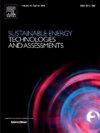Thermal propagation model and numerical simulation of high-specific energy lithium-ion battery packs induced by the spatio-temporal dispersion of multiple heat sources
IF 7.1
2区 工程技术
Q1 ENERGY & FUELS
Sustainable Energy Technologies and Assessments
Pub Date : 2025-07-18
DOI:10.1016/j.seta.2025.104456
引用次数: 0
Abstract
Thermal abuse serve as a direct trigger for thermal runaway in lithium-ion batteries. In this paper, we propose a numerical model of thermal propagation that incorporates partial differential equations for heat transfer, ordinary differential equations, fluid heat transfer and thermal radiation. A high-specific-energy battery pack comprising square lithium-ion cells is established, and the thermal runaway propagation process within this pack is explored using the finite element method. To simulate the thermal runaway propagation phenomenon induced by spatio-temporal dispersive heat sources, a thermal propagation model is constructed. Compared to the convection-only model, the proposed model exhibits a difference of 40 K in peak temperature and 65 s in thermal spreading time. Similarly, when compared to the thermal radiation-only model, the differences are 120 K and 60 s, respectively. Furthermore, the thermal propagation characteristics of the battery module under three different gaps are analyzed, revealing that increasing the battery gap slows down the thermal propagation time and peak thermal runaway temperature of the cell but reduces the energy density of the battery pack. A multi-indicator comprehensive evaluation system is established based on this model to assess the thermal runaway propagation hazard index. This study provides practical guidance for the design of battery thermal management systems.
多热源时空分散诱导高比能锂离子电池组热传播模型及数值模拟
热滥用是锂离子电池热失控的直接诱因。在本文中,我们提出了一个热传播的数值模型,它包含了传热的偏微分方程、常微分方程、流体传热和热辐射。建立了由方形锂离子电池组成的高比能电池组,并利用有限元方法研究了该电池组内的热失控传播过程。为了模拟由时空色散热源引起的热失控传播现象,建立了热传播模型。与纯对流模式相比,该模式的峰值温度相差40 K,热扩散时间相差65 s。同样,与仅热辐射模式相比,差异分别为120 K和60 s。进一步分析了三种不同间隙下电池模块的热传播特性,发现增大电池间隙会减缓电池的热传播时间和峰值热失控温度,但会降低电池组的能量密度。在此基础上建立了多指标综合评价体系,对热失控传播危害指数进行了评价。本研究为电池热管理系统的设计提供了实践指导。
本文章由计算机程序翻译,如有差异,请以英文原文为准。
求助全文
约1分钟内获得全文
求助全文
来源期刊

Sustainable Energy Technologies and Assessments
Energy-Renewable Energy, Sustainability and the Environment
CiteScore
12.70
自引率
12.50%
发文量
1091
期刊介绍:
Encouraging a transition to a sustainable energy future is imperative for our world. Technologies that enable this shift in various sectors like transportation, heating, and power systems are of utmost importance. Sustainable Energy Technologies and Assessments welcomes papers focusing on a range of aspects and levels of technological advancements in energy generation and utilization. The aim is to reduce the negative environmental impact associated with energy production and consumption, spanning from laboratory experiments to real-world applications in the commercial sector.
 求助内容:
求助内容: 应助结果提醒方式:
应助结果提醒方式:


